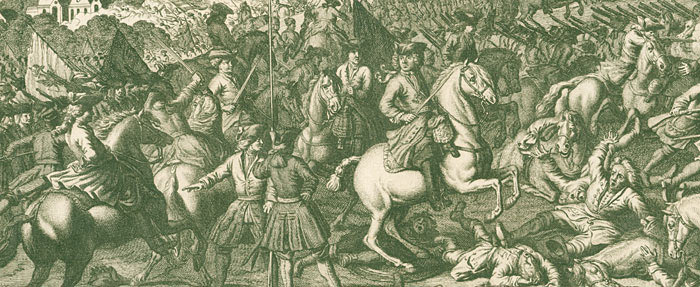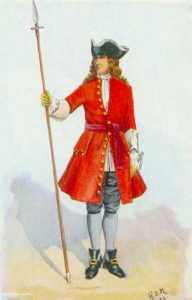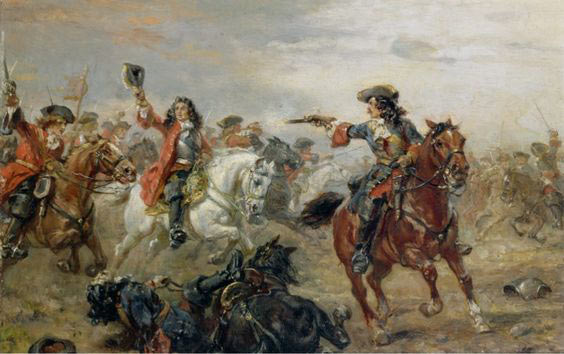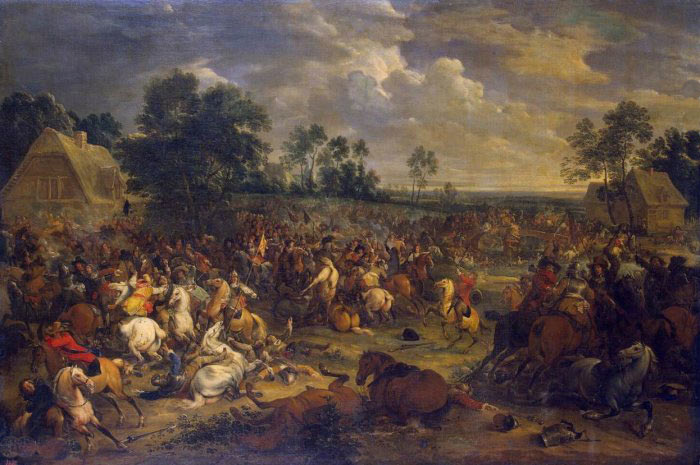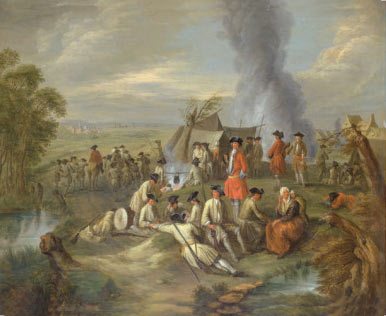The Duke of Marlborough’s third defeat in the field of the French army of Louis XIV
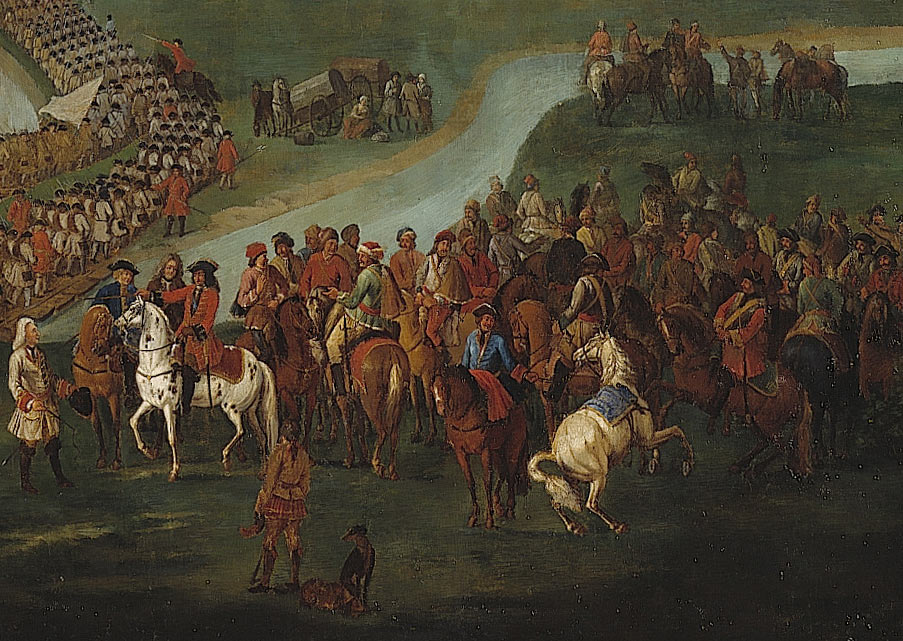
French troops crossing the Norken River at the Battle of Oudenarde 30th June 1708 in the War of the Spanish Succession
The previous battle of the War of the Spanish Succession is the Battle of Ramillies
The next battle of the War of the Spanish Succession is the Battle of Malplaquet
To the War of the Spanish Succession index
War: Spanish Succession
Date of the Battle of Oudenarde: 30th June 1708 (Old Style) (11th July1708 New Style). The dates in this page are given in the Old Style.
Place of the Battle of Oudenarde: Flanders.
Combatants at the Battle of Oudenarde: British, Dutch, Austrians, Hanoverians, Prussians and Danes against the French and Bavarians. Scots, Irish, Swiss and Germans fought in the battle on both sides.
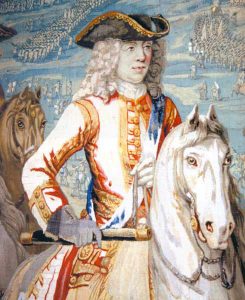
Duke of Marlborough at the Battle of Oudenarde 30th June 1708 in the War of the Spanish Succession: Blenheim Palace Tapestry
Generals at the Battle of Oudenarde: The Duke of Marlborough and Prince Eugene of Savoy against the Duke of Burgundy and Marshal Vendôme.
Size of the armies at the Battle of Oudenarde: Marlborough’s army numbered 80,000 men (112 battalions, 180 squadrons and 113 guns). The French army numbered around 95,000 men (124 battalions, 197 squadrons and 120 guns).
Uniforms, arms and equipment at the Battle of Oudenarde:
The British Army of Queen Anne comprised troops of Horse Guards, regiments of horse, dragoons, Foot Guards and foot. In time of war the Department of Ordnance provided companies of artillery, the guns drawn by the horses of civilian contractors.
These types of formation were largely standard throughout Europe. In addition the Austrian Empire possessed numbers of irregular light troops; Hussars from Hungary and Bosniak and Pandour troops from the Balkans. During the 18th Century the use of irregulars spread to other armies until every European force employed hussar regiments and light infantry for scouting duties.
Horse and dragoons carried swords and short flintlock muskets. Dragoons had largely completed their transition from mounted infantry to cavalry and were formed into troops rather than companies as had been the practice in the past. However they still used drums rather than trumpets for field signals.
Infantry regiments fought in line, armed with flintlock musket and bayonet, orders indicated by the beat of drum. The field unit for infantry was the battalion comprising ten companies, each commanded by a captain, the senior company being of grenadiers. Drill was rudimentary and once battle began formations quickly broke up. The practice of marching in step was in the future.
The paramount military force of the period was the French army of Louis XIV, the Sun King. France was at the apex of her power, taxing to the utmost the disparate groupings of European countries that struggled to keep the Bourbons on the western bank of the Rhine and north of the Pyrenees.
Marlborough and his British regiments acted as an uncertain mortar in keeping the edifice of the Imperial cause in Flanders intact.
The War of the Spanish Succession was an early outing for the new British Army established after the Restoration in 1685. The regiments that took the field were the forebears of powerful Victorian institutions; Foot Guards, King’s Horse, Royal Dragoons, Royal Scots, Buffs, Royal Welch Fusiliers, Cameronians, Royal Scots Fusiliers and several other prestigious corps.
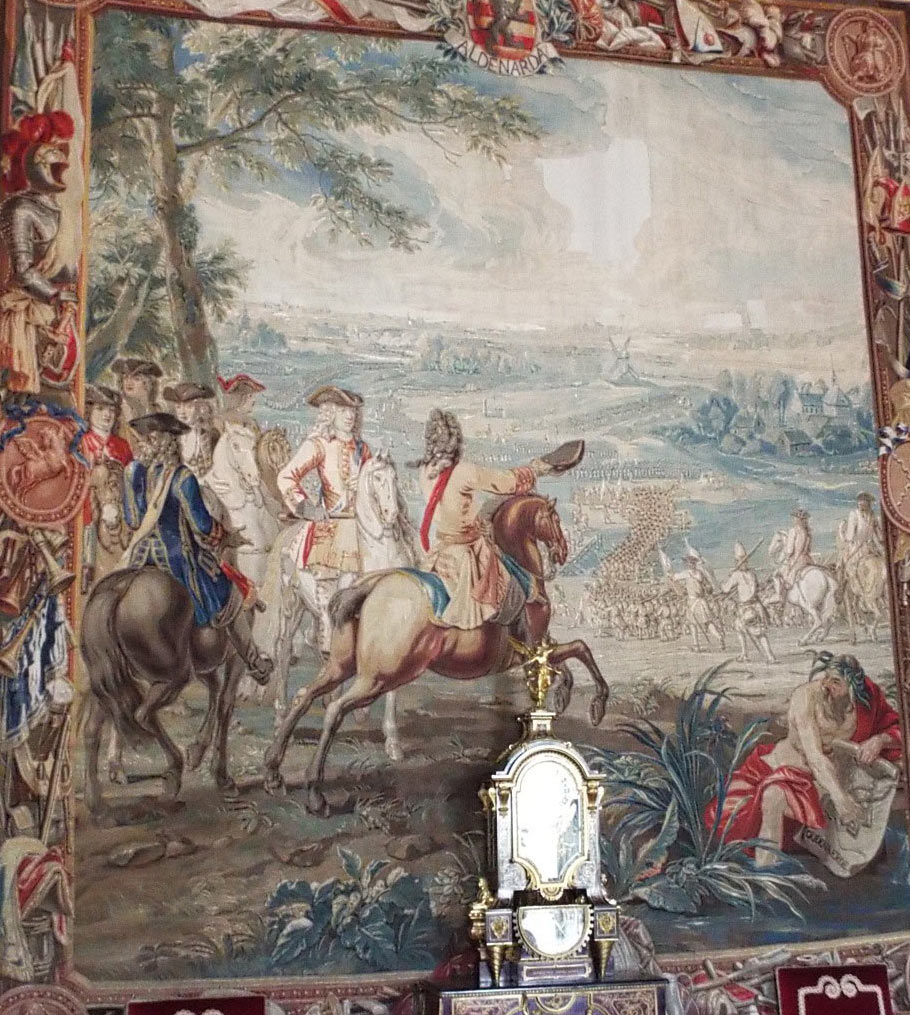
Duke of Marlborough at the Battle of Oudenarde 30th June 1708 in the War of the Spanish Succession: Blenheim Palace Tapestry
Britain fell behind its continental enemies and allies in many respects. There was no formal military education for officers of the Army, competence coming from experience on the field of battle. Commissions in the horse, dragoons and foot were acquired by purchase, permitting the wealthy to achieve often unmerited promotion.
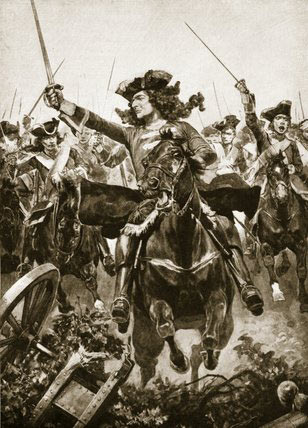
Duke of Marlborough leading the attack at the Battle of Oudenarde 30th June 1708 in the War of the Spanish Succession: picture by Richard Caton Woodville
Support services were not formally established and depended on the commander. A major contributing feature to the Duke of Marlborough’s success in the field was his concern that his soldiers be properly supplied and by his consummate ability to organise and administer that supply.
While every army had formal and explicit rank structures the realities of command and influence were still largely decided by social standing, particularly between armies of different nationality. It was a matter of necessity for John Churchill to have the status of Duke of Marlborough to enable him to exercise decisive influence over the fractious foreign officers he had to work with and over some of his own nationality. In reality his status as duke, while probably of greater significance than his military rank of Captain General, was insufficient to enable him to act as a true commander-in-chief rather than as quasi-chairman of a committee of Dutch, Austrian and British generals.
The uniform of the British Regiments was the long red coat turned back at the lapels and cuffs to show the facings of the regimental colour; dark blue for guards and royal regiments; yellow, green, white or buff for many of the others. The Royal Horse Guards wore blue uniforms; as did the artillery, an organization not yet incorporated into the army proper.
Headgear was the tricorne hat, except for the company of grenadiers in each battalion of foot, the Horse Grenadier Guards, the Royal North British Dragoons (Scots Greys), the three regiments of fusiliers (Royal, Royal North British and Royal Welch) and the drummers of dragoons and foot, all of whom wore the mitre cap.
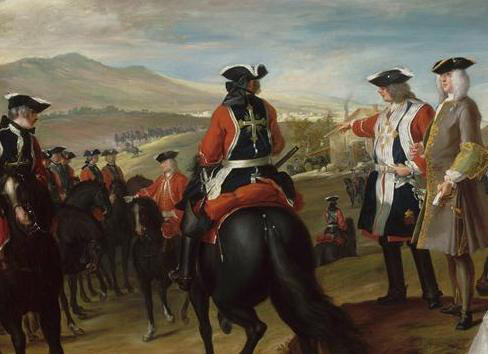
French Maison du Roi at the Battle of Oudenarde 30th June 1708 in the War of the Spanish Succession: picture by de Sery
For the infantry a cross belt carried the cartridge case hanging on the right hip. A second cross belt carried the bayonet and hanger sword. Ammunition, carried in the cartridge case, comprised cartridges of paper wrap containing the ball and gunpowder.
For the other European armies national uniforms were in their infancy. The Danish infantry wore grey coats and breeches with green stockings. Some Danish cavalry regiments wore the old buff coats. Hanoverian regiments had taken to wearing red coats. The Prussian army wore dark blue. The Dutch army wore a motley of uniforms although the Guards wore blue and were referred to as the Blue Guards. The native French regiments wore white coats. The foreign regiments in French service, the Scots, Irish and Swiss wore red coats.
Winner of the Battle of Oudenarde: The Allied Army under the Duke of Marlborough and Prince Eugene of Savoy; decisively.
British Regiments at the Battle of Oudenarde:
King’s Regiment of Horse; later the King’s Dragoon Guards and now the 2nd Queen’s Dragoon Guards.
3rd Regiment of Horse; later the 3rd Dragoon Guards, then the 3rd Carabineers and now the Royal Dragoon Guards.
5th Regiment of Horse; later the 5th Dragoon Guards, then the 5th Inniskilling Dragoon Guards and now the Royal Dragoon Guards.
6th Regiment of Horse; later the 6th Dragoon Guards, then the 3rd Carabineers and now the Royal Scots Dragoon Guards.
7th Regiment of Horse; later the 7th Dragoon Guards, then the 4th/7th Royal Dragoon Guards and now the Royal Dragoon Guards.
Royal North British Regiment of Dragoons; the Royal Scots Greys and now the Royal Scots Dragoon Guards.
5th Dragoons; later the 5th Lancers, then the 16th/5th Royal Lancers and now the Royal Lancers.
1st Regiment of Foot Guards; now the Grenadier Guards.
The Coldstream Regiment of Foot Guards.
The Royal Regiment; now the Royal Scots.
3rd Foot, the Buffs; now the Princess of Wales’s Royal Regiment.
8th King’s Foot; now the King’s Regiment.
10th Foot; later the Lincolnshire Regiment and now the Royal Anglian Regiment.
15th Foot; later the East Yorkshire Regiment and now the Prince of Wales’s Regiment of Yorkshire.
16th Foot; later the Bedfordshire Regiment and now the Royal Anglian Regiment.
Royal Irish; disbanded in 1922.
Royal Scots Fusiliers.
Royal Welch Fusiliers.
24th Foot; later the South Wales Borderers and now the Royal Regiment of Wales.
26th Foot, the Cameronians; later the Scottish Rifles, disbanded in 1968.
28th Foot; later the Gloucestershire Regiment and now the Royal Gloucestershire, Berkshire and Wiltshire Regiment.
29th Foot; later the Worcestershire Regiment and now the Worcestershire and Sherwood Foresters Regiment.
37th Foot: later the Royal Hampshire Regiment and now the Princess of Wales’s Royal Regiment.
Royal Artillery.
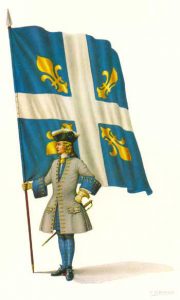
French Officer with Regimental Colour: Battle of Oudenarde 30th June 1708 in the War of the Spanish Succession
Background to the Battle of Oudenarde:
The 1708 campaigning season started late and in some confusion. The King of France, Louis XIV planned to subvert the allied war effort by means of a Jacobite uprising in Scotland to place the Old Pretender on the thrones of Great Britain but the plan had to be deferred.
The Duke of Marlborough reached Holland in early April 1708 to meet Prince Eugene of Savoy, his close confederate of long standing, and plan the campaign to be fought in the summer of 1708.
While Marlborough commanded in Flanders Prince Eugene would bring the Imperial forces on the Moselle River north to join Marlborough for a decisive blow at the French and Bavarians.
For the year’s campaign a junior commander joined Prince Eugene, the Electoral Prince of Hanover later to be King George II of England.
Louis XIV harboured an ambition to revenge the crushing defeats his armies had suffered at the Battles of Blenheim and Ramillies at the hands of the Duke of Marlborough. To that end French troops flowed into Flanders as they could be spared from other theatres.
The heir to the French throne, the Duke of Burgundy nominally commanded the French army, with Marshal Vendôme, an experienced soldier present to provide informed advice. Burgundy’s brother, the Duke de Berry and the Old Pretender, the Chevalier de Sainte George assisted in the high command.
In May 1708 the French army marched north into the heart of Flanders, causing Marlborough to send an urgent message to Prince Eugene, summoning him from the Moselle. While in need of the Imperial troops as reinforcements, Marlborough had a greater need for the assistance of his trusted colleague, the Prince.
The opposing armies manoeuvred across Flanders without meeting, the French taking Ghent and Bruges and threatening Brussels.

Map of the Battle of Oudenarde 30th June 1708 in the War of the Spanish Succession: map by John Fawkes
Account of the Battle of Oudenarde:
In late June 1708 with the surrender of the citadel in Ghent, Vendôme was free to move on the town of Oudenarde strategically important with its crossing point over the Scheldt River. The French army crossed the Scheldt to the North of the town on 30th June 1708.
Marlborough ordered a Dutch officer to throw himself into Oudenarde with such troops as he could muster and resist the French while Marlborough brought up the main army by a series of forced marches.
On the day Vendôme crossed the Scheldt to threaten the town, Cadogan, Marlborough’s trusted Quartermaster General arrived at the river bank north of Oudenarde with the leading troops of the allied army and began assembling a pontoon bridge.
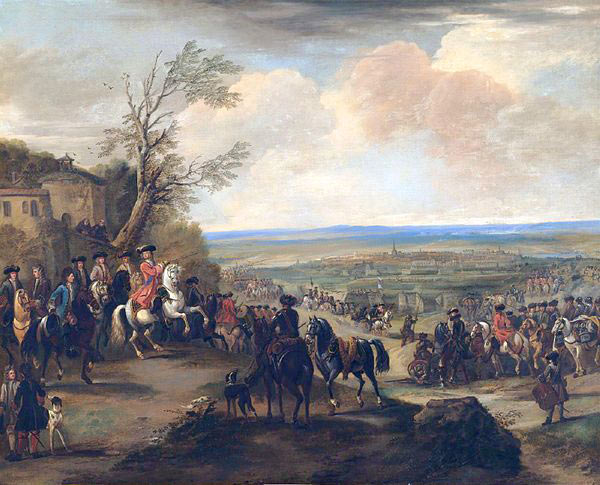
Duke of Marlborough at the Battle of Oudenarde 30th June 1708 in the War of the Spanish Succession: picture by John Wootton
The French advanced guard of horse, commanded by the Marquis de Biron who was unaware of the presence of Cadogan’s force, moved up the west bank of the river towards Oudenarde the French soldiers foraging as they went.
Biron was peremptorily informed of the allied presence when Cadogan’s horse attacked the dispersed French foragers. Hurrying to the front Biron saw that Marlborough himself was now crossing the Scheldt with a contingent of Prussian horse that he had rushed forward to support his Quartermaster General. Biron passed the information back to Marshall Vendôme.
On receipt of Biron’s intelligence Vendôme realized that he had an opportunity to attack the allied army while much of it was still on the far side of the Scheldt. He ordered the French army take up a position along the heights above Oudenarde on the eastern side of the Norken River. Seven French battalions from the Swiss regiments of Phiffer, Villars and Greder were ordered forward forthwith to occupy and hold the village of Heurne.
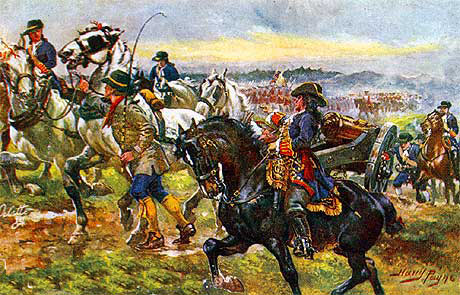
Bringing up the guns: Battle of Oudenarde 30th June 1708 in the War of the Spanish Succession: picture by Harry Payne
The Duke of Burgundy, considering Vendôme’s dispositions to be excessively rash, overruled the experienced marshal and directed that the army take up positions on the heights to the west of the Norken River.
The French army formed up in conformance with Burgundy’s new orders, other than the seven battalions that continued to execute the orders received from Vendôme. Unfortunately the commander mistook the village he was directed to occupy and marched on to Eine, nearer to Oudenarde and even more dangerously exposed than Heurne.
As the French took up their positions behind the Norken River the allied army came up to the Scheldt, regiments crossing to the West, either by the town bridges in Oudenarde or by Cadogan’s pontoons.
With this gathering support Cadogan’s troops moved forward to Eine and, with the cavalry circling to the rear of the village to cut off the French, launched an attack on the seven battalions, the British regiments of Sabine’s brigade leading the assault. All seven French battalions were either annihilated or surrendered.
The allied cavalry, led by Prince George, the Electoral Prince of Hanover (later King George II of England), then assaulted the few supporting French squadrons. During the fight Prince George’s horse was shot under him.
With his army fully in position behind the Norken, the Duke of Burgundy expected that he would be attacked and prepared for a general engagement. But Marlborough’s army, still coming up and crossing the Scheldt was not yet ready to give battle.
At 4pm, in the continuing absence of an allied assault the impatient Burgundy resolved to launch a French attack across the Norken and moved his cavalry across the river with the whole of the centre and right flank. Against this advance Marlborough deployed the limited resources that had by now crossed the Scheldt.
On the right flank Cadogan ordered two battalions of Prussian foot into Groenewald, a village immediately threatened by the French advance while Marlborough sent forward twelve more battalions of foot, several of them British, with British and Prussian cavalry taking post on the heights at Bevere and Heurne in support.
At around 5.30pm thirty French battalions began an assault on the two Prussian battalions in Groenewald. The supporting force soon came up and a fierce struggle developed around the village.
More allied battalions crossed the Scheldt and hurried forward to form up on the left of the battle line, which was fast extending to the west as French troops crossed the Norken and joined the attack.
Prince Eugene took eighteen battalions to the right flank in support of Cadogan, whose troops had been forced out of Groenewald while the Prussian cavalry launched an attack on the French left that while initially successful was finally repelled with heavy casualties.
In the allied centre and left, where the Dutch and Hanoverian battalions were deployed, the infantry fight reached stalemate with neither side able to make significant progress. There were however no more French battalions coming across the Norken River to extend the line. Marlborough launched twenty battalions of Dutch and Danish foot in an attack around the end of the French right flank. A powerful force of cavalry under the Dutch General Auverquerque struck wider still attacking the French cavalry in the rear of their line. The French right was surrounded and began to collapse.
To relieve the pressure on the centre and right of the French army Vendôme and Burgundy attempted to bring the French left across the Norken and into the battle but they were unable to cross the river.
The battle ended with the fall of darkness, Prince Eugene’s battalions beating the French assembly and Huguenot officers calling the names of the French regiments so that parties of stragglers marched in only to be made prisoners.
The French army streamed away from the battlefield in the gathering gloom in considerable disorder, saved from greater disaster by the onset of night.
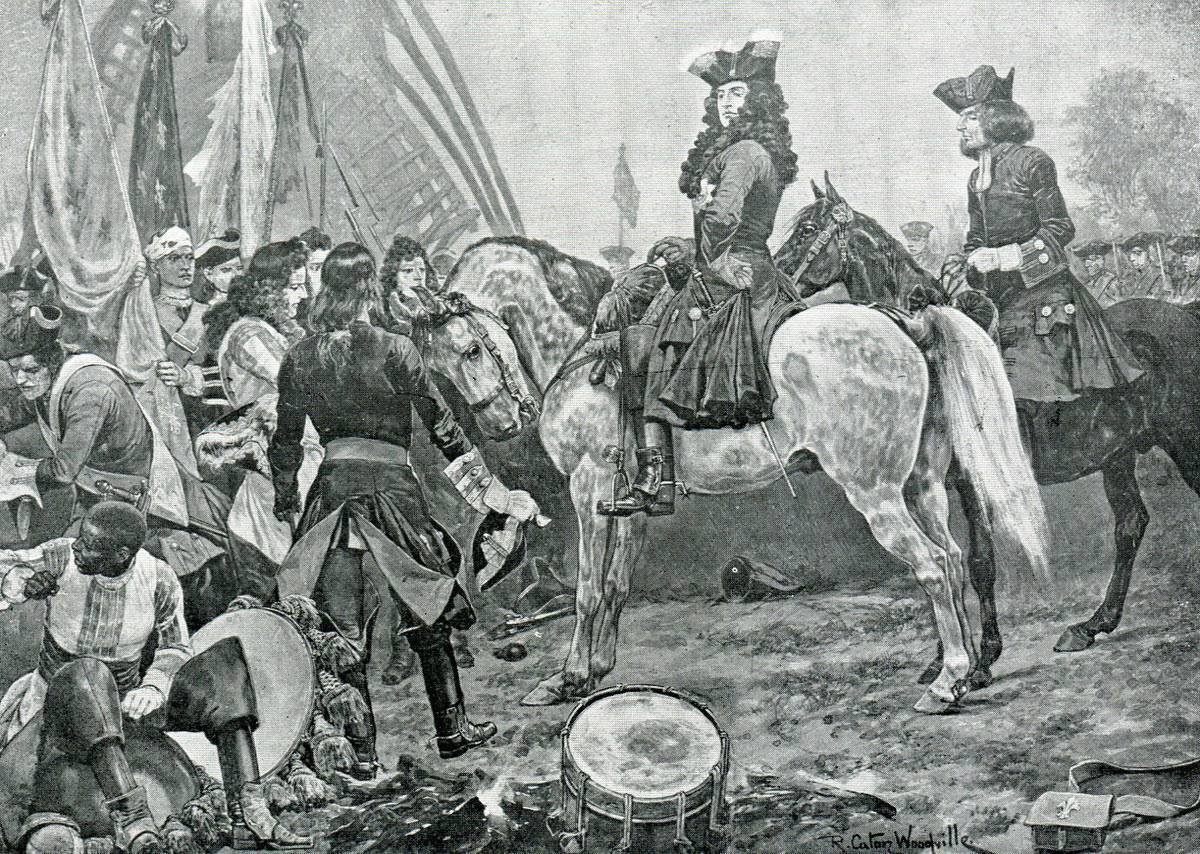
Duke of Marlborough accompanied by Dr Hare visiting French prisonners after the Battle of Oudenarde 30th June 1708 in the War of the Spanish Succession: picture by Richard Caton Woodville
Casualties at the Battle of Oudenarde: The French army lost 5,000 dead, 9,000 prisoners and 6,000 soldiers who deserted. The allies suffered 5,000 casualties. The allies took 10 French guns.
Follow-up: The next morning British and Prussian cavalry resumed the pursuit of the French army and crossed the border into France reaching the outskirts of Arras.
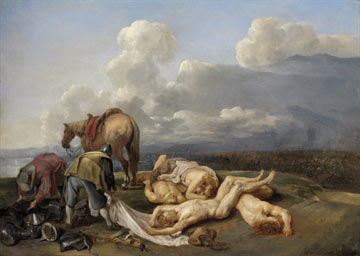
Aftermath of battle: Battle of Oudenarde 30th June 1708 in the War of the Spanish Succession: picture by van de Hecke
Regimental anecdotes and traditions from the Battle of Oudenarde:
- The Duke of Marlborough lamented that the fall of night limited the extent of the victory. “Another hour of daylight would have enabled me to finish the war” he is reported to have said.
- King George II of England fought at Oudenarde with the Hanover Horse and had his horse shot under him. In later life King George II would produce his “Oudenarde Sword”. The King is memorable for commanding the British and Allied Army at the Battle of Dettingen in June 1743.
- See the British Battles blog on the tapestries commemorating the Duke of Marlborough’s victories during the War of the Spanish Succession at Blenheim Palace.
References:
- Marlborough as military commander by David Chandler
- Fortescue’s History of the British Army Volume 1.
- Grant’s British Battles.
- Sullivan’s Irish Brigades in the Service of France.
The previous battle of the War of the Spanish Succession is the Battle of Ramillies
The next battle of the War of the Spanish Succession is the Battle of Malplaquet
To the War of the Spanish Succession index
